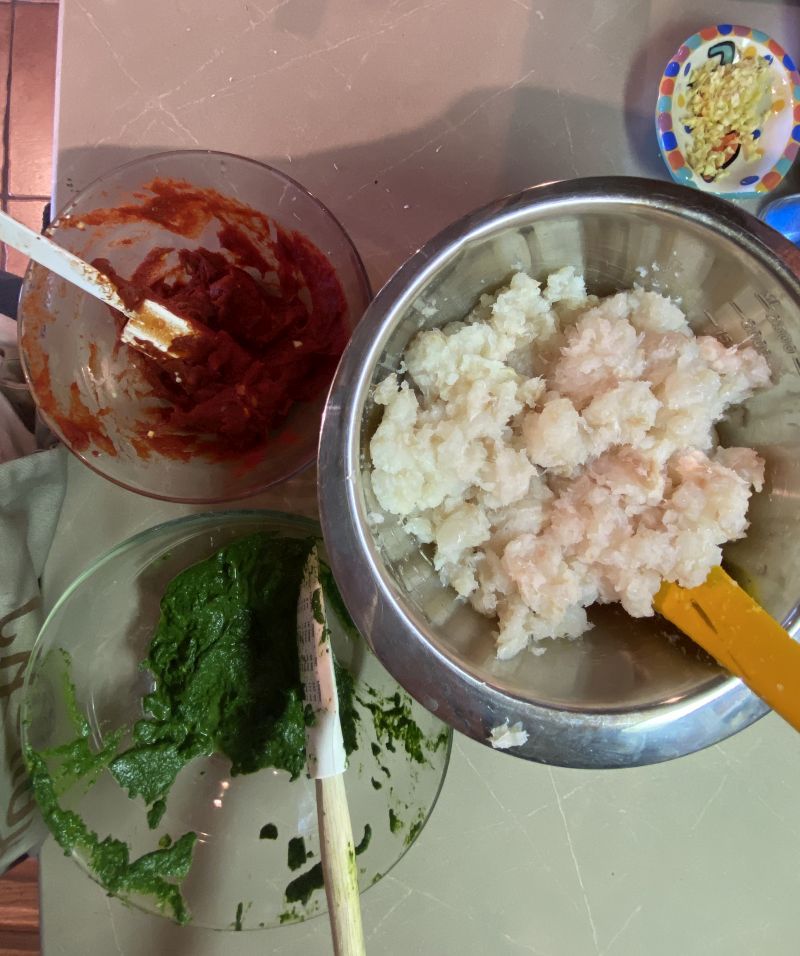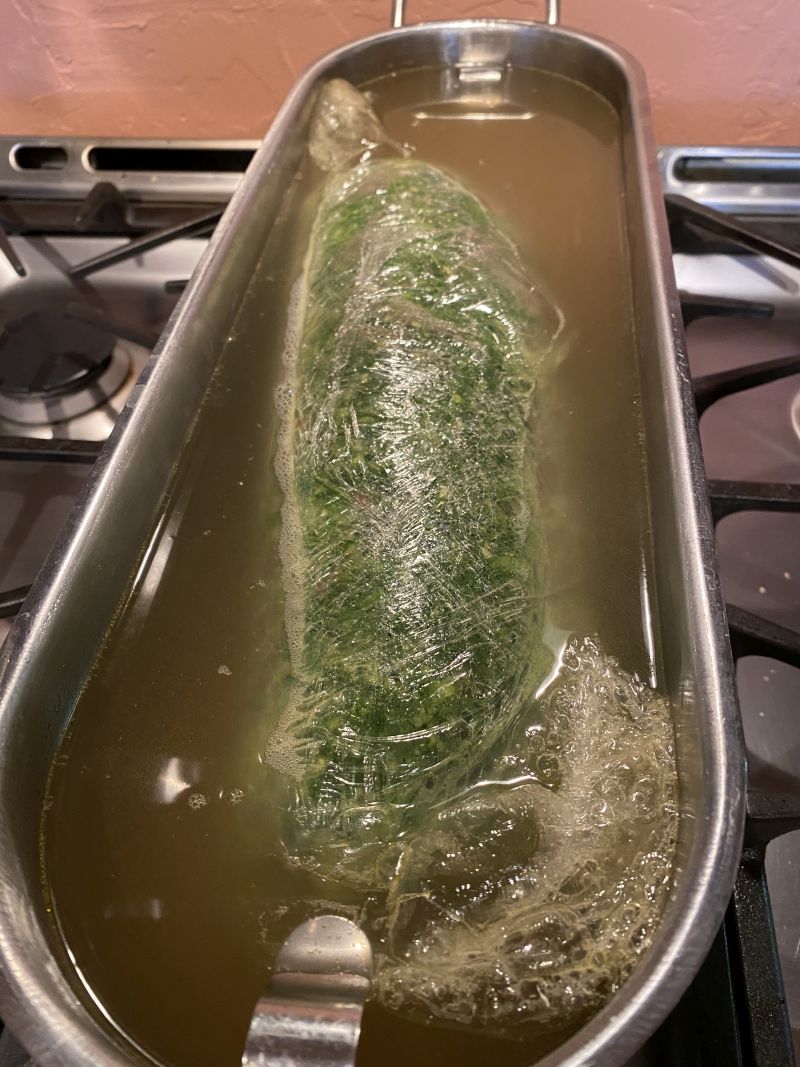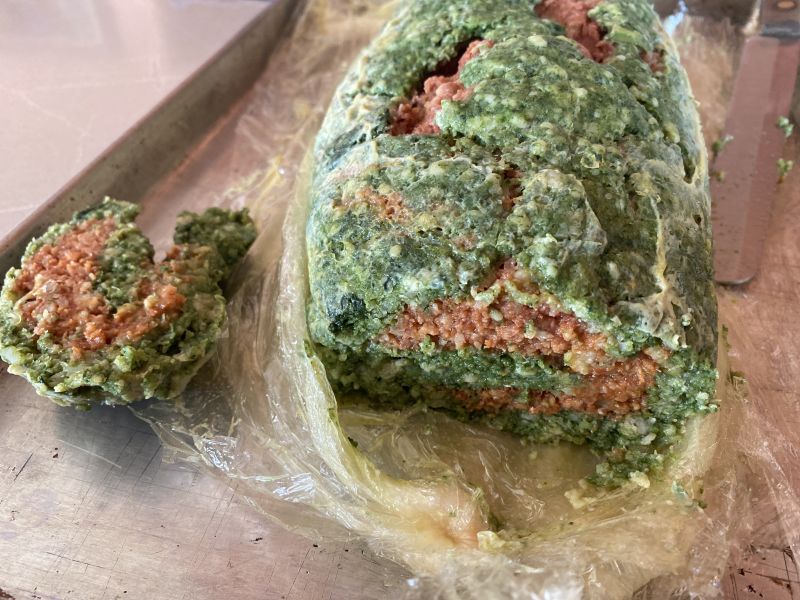Four Layer Homemade Gefilte Fish
See photos in Notes
Print Recipe
Ingredients
- 2½ lbs whitefish, boneless & skinless (You can use carp, whitefish, pike or cod)
- ½ lb salmon filet, boneless and skinless
- ¾ cup matzah meal
- 3 large eggs
- ½ cup green onions, chopped with green tops (could sub (fresh dill)
- 1 Tbsp garlic, chopped
- 1 Tbsp olive oil
- 6 oz fresh baby spinach
- 1 tsp fresh ginger, minced (or sub ¼ tsp ground ginger
- ½ cup tomato paste
- 3 tsp kosher salt
- 1 tsp black pepper
- 3 qts chicken or vegetable stock enough to cover (can add water)
- additional salt & pepper to taste
Instructions
Prep Work
- Peel and mince the garlic.
- Peel and chop the ginger.
- Heat olive oil in a large sauté pan over medium heat. Add garlic and sauté it until golden. Add spinach and stir constantly until it is wilted - approximately 3 minutes. Season spinach with a little salt and pepper. Add 1/2 cup broth.
- Purée the spinach mixture until smooth in a blender. Set aside.
- Cut salmon into 4 long strips. Season with salt and pepper.
Fish Bases
- 1. Chop the whitefish in small batches in a food processor using the chopping blade or grind in a meat grinder. Leave it coarse and with a few chunks of fish.
- Combine eggs, ground white fish, matzah meal, salt, and pepper in a large bowl. Mix together until smooth but do not over mix it.
- Divide the fish base evenly into 3 bowls.
- Mix spinach/garlicpurée into one of the bowls of fish base. Stir until well combined.
- Mix tomato paste and ginger into the second bowl of fish base. Stir until well combined.
- Mix the sliced green onions (or chopped dill) into the third bowl of the fish base. Stir until well combined.
Assemble the Roll
- Place a 2-foot long piece of plastic wrap on your counter.
- Spread the spinach/fish base into a rectangle on the plastic wrap, approximately 12” x 9”.
- Spread the tomato/fish base on top of the spinach base. Leave about 1/2” border all around.
- Spread the green onion/fish base (or chopped dill fish base) on top of the tomato fish base. Leave about 1/2” border of the tomato fish base exposed.
- Try to keep all bases as rectangular as possible.
- Place the salmon strips end to end down the center of the green onion/fish base.
Assembly
- Place a 2-foot long piece of plastic wrap on the counter.
- Spread the spinach fish base into a rectangle on the plastic wrap, approximately 12” x 9”,
- Spread the tomato fish base on top of the spinach base. Leave about 1/2” border all around.
- Spread the green onion fish base (or chopped dill fish base) on top of the tomato fish base. Leave about 1/2” border of the tomato fish base exposed.
- Try to keep all bases as rectangular as possible.
- Place the salmon strips end to end down the center of the scallion fish base.
- Using the plastic wrap to help, roll the layered fish into a log, slightly overlapping the edges of the spinach fish base. Set the log aside
- Put two overlapping 2 foot long pieces of plastic wrap on the counter.
- Turn the gefilte fish log 90 degrees and place it on the end of the overlapped plastic. Roll the log as tightly as you can in the overlapped plastic. Set aside.
- Put a more 2’ long piece of plastic wrap on the counter. Turn the gefilte fish log 90 degrees and wrap it tightly in this last piece of plastic wrap.
- Twist the ends of the plastic tightly and tight in a knot to secure them.
- Place gefilte fish log in a roasting pan and cover with chicken or vegetable broth. (If you need to top it off with water, it works).
- Place the pan on the stove, cover it with foil and bring it to a simmer. (If you have a fish poacher it is perfect to use for this).
- Simmer gefilte fish for 1½ hours. Internal temperature should be 155° F.
- Carefully pull the cooked gefilte fish log out of the broth, place it on a flat pan and refrigerate it overnight (or 8 hours minimum).
- When fully chilled, carefully unwrap the log and slice the gefilte fish. Serve with traditional beet horseradish or sesame vinaigrette.
Notes
You can make your own Fresh Horesreadish using beets from my recipe
I am not sure where I got this recipe but here are the accompanying notes. I believe a rabbi of a friend sent to me after we discussed it on social media but I cannot find the references to that.
Ari Sobel’s Four-Layer Homemade Gefilte Fish
(Notes from Ari – who is a Culinary Institute of America trained chef, Cornell School of Hotel Administration graduate, and Founder and CEO of Herb’N Garden Farms – “this recipe sounds complicated, but it will only take about 15-20 minutes start to finish. Think of this as meat loaf, but made with fish. It is chopped fish, mixed with egg and a binder and spices. You spread it in layers on a sheet of plastic wrap, lay some slices of fresh salmon down the middle, sushi style (see photo) – and roll it up. Wrap it in saran, tightly, wrap another layer of saran, knot the ends, and poach it gently on the stove. Let it cool in the poaching liquid for about 8 hours in the fridge. It can then be frozen – cooked – or eaten right away. It will also stay fresh for about 5 days in the fridge. You can also cook this “sous vide” method, or – you can cook it instead in a parchment paper, pam-sprayed loaf pan and bake it at 350 degrees F for about an hour or so.)






